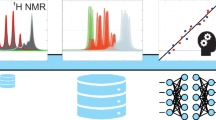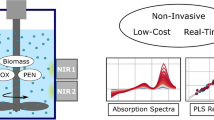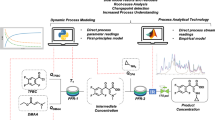Abstract
Monitoring specific chemical properties is the key to chemical process control. Today, mainly optical online methods are applied, which require time- and cost-intensive calibration effort. NMR spectroscopy, with its advantage being a direct comparison method without need for calibration, has a high potential for enabling closed-loop process control while exhibiting short set-up times. Compact NMR instruments make NMR spectroscopy accessible in industrial and rough environments for process monitoring and advanced process control strategies. We present a fully automated data analysis approach which is completely based on physically motivated spectral models as first principles information (indirect hard modeling—IHM) and applied it to a given pharmaceutical lithiation reaction in the framework of the European Union’s Horizon 2020 project CONSENS. Online low-field NMR (LF NMR) data was analyzed by IHM with low calibration effort, compared to a multivariate PLS-R (partial least squares regression) approach, and both validated using online high-field NMR (HF NMR) spectroscopy.

NMR sensor module for monitoring of the aromatic coupling of 1-fluoro-2-nitrobenzene (FNB) with aniline to 2-nitrodiphenylamine (NDPA) using lithium-bis(trimethylsilyl) amide (Li-HMDS) in continuous operation. Online 43.5 MHz low-field NMR (LF) was compared to 500 MHz high-field NMR spectroscopy (HF) as reference method









Similar content being viewed by others
References
Wiles C, Watts P. Continuous flow reactors: a perspective. Green Chem. 2012;14(1):38.
Adamo A, Beingessner RL, Behnam M, Chen J, Jamison TF, Jensen KF, et al. On-demand continuous-flow production of pharmaceuticals in a compact, reconfigurable system. Science. 2016;352(6281):61.
Zhang P, Terefenko EA, McComas CC, Mahaney PE, Vu A, Trybulski E, et al. Synthesis and activity of novel 1- or 3-(3-amino-1-phenyl propyl)-1,3-dihydro-2H-benzimidazol-2-ones as selective norepinephrine reuptake inhibitors. Bioorg Med Chem Lett. 2008;18(23):6067.
Bieringer T, Buchholz S, Kockmann N. Future production concepts in the chemical industry: modular–small-scale–continuous. Chem Eng Technol. 2013;36(6):900.
Chinnusamy T, Yudha SS, Hager M, Kreitmeier P, Reiser O. Application of metal-based reagents and catalysts in microstructured flow devices. ChemSusChem. 2012;5(2):247.
Meyer K, Kern S, Zientek N, Guthausen G, Maiwald M. Process control with compact NMR. TrAC Trends Anal Chem. 2016;83(Part A):39.
Maiwald M, Gräßer P, Wander L, Zientek N, Guhl S, Meyer K, et al. Strangers in the night—smart process sensors in our current automation landscape. PRO. 2017;1:628. https://doi.org/10.3390/proceedings1040628.
Edwards JC, Giammatteo PJ. In: Bakeev KA, editor. Process Analytical Technology. Hoboken: John Wiley & Sons, Ltd; 2010. https://doi.org/10.1002/9780470689592.ch10.
Ferstl W, Klahn T, Schweikert W, Billeb G, Schwarzer M, Loebbecke S. Inline analysis in microreaction technology: a suitable tool for process screening and optimization. Chem Eng Technol. 2007;30(3):370.
Leung S-A, Winkle RF, Wootton RCR, de Mello AJ. A method for rapid reaction optimisation in continuous-flow microfluidic reactors using online Raman spectroscopic detection. Analyst. 2005;130(1):46.
Floyd TM, Schmidt MA, Jensen KF. Silicon micromixers with infrared detection for studies of liquid-phase reactions. Ind Eng Chem Res. 2005;44(8):2351.
Markley JL. NMR analysis goes nano. Nat Biotechnol. 2007;25(7):750.
Maiwald M, Fischer HH, Kim Y-K, Albert K, Hasse H. Quantitative high-resolution on-line NMR spectroscopy in reaction and process monitoring. J Magn Reson. 2004;166(2):135.
Zientek N, Laurain C, Meyer K, Kraume M, Guthausen G, Maiwald M. Simultaneous 19F–1H medium resolution NMR spectroscopy for online reaction monitoring. J Magn Reson. 2014;249:53.
Mitchell J, Gladden LF, Chandrasekera TC, Fordham EJ. Low-field permanent magnets for industrial process and quality control. Prog Nucl Magn Reson Spectrosc. 2014;76:1.
Zalesskiy SS, Danieli E, Blümich B, Ananikov VP. Miniaturization of NMR systems: desktop spectrometers, microcoil spectroscopy, and “NMR on a Chip” for chemistry, biochemistry, and industry. Chem Rev. 2014;114(11):5641.
Dalitz F, Cudaj M, Maiwald M, Guthausen G. Process and reaction monitoring by low-field NMR spectroscopy. Prog Nucl Magn Reson Spectrosc. 2012;60:52.
Blümich B. Introduction to compact NMR: a review of methods. TrAC Trends Anal Chem. 2016;83(Part A):2.
Singh K, Blümich B. NMR spectroscopy with compact instruments. TrAC Trends Anal Chem. 2016;83(Part A):12.
Gouilleux B, Charrier B, Danieli E, Dumez J-N, Akoka S, Felpin F-X, et al. Real-time reaction monitoring by ultrafast 2D NMR on a benchtop spectrometer. Analyst. 2015;140(23):7854.
Wynn DA, Roth MM, Pollard BD. The solubility of alkali-metal fluorides in non-aqueous solvents with and without crown ethers, as determined by flame emission spectrometry. Talanta. 1984;31(11):1036.
Mazet V, Carteret C, Brie D, Idier J, Humbert B. Background removal from spectra by designing and minimising a non-quadratic cost function. Chemom Intell Lab Syst. 2005;76(2):121.
Chen L, Weng ZQ, Goh LY, Garland M. An efficient algorithm for automatic phase correction of NMR spectra based on entropy minimization. J Magn Reson. 2002;158(1–2):164.
Savorani F, Tomasi G, Engelsen SB. icoshift: a versatile tool for the rapid alignment of 1D NMR spectra. J Magn Reson. 2010;202(2):190.
Michalik-Onichimowska A, Kern S, Riedel J, Panne U, King R, Maiwald M. “Click” analytics for “click” chemistry—a simple method for calibration–free evaluation of online NMR spectra. J Magn Reson. 2017;277:154.
Kriesten E, Alsmeyer F, BardoW A, Marquardt W. Fully automated indirect hard modeling of mixture spectra. Chemom Intell Lab Syst. 2008;91(2):181.
Dondoni A, Giovannini PP, Massi A. Assembling heterocycle-tethered C-glycosyl and alpha-amino acid residues via 1,3-dipolar cycloaddition reactions. Org Lett. 2004;6(17):2929.
Kessler W. Multivariate Datenanalyse. Weinheim: Wiley-VCH Verlag GmbH & Co KGaA; 2006. https://doi.org/10.1002/9783527610037.ch4.
Westad F, Marini F. Validation of chemometric models—a tutorial. Anal Chim Acta. 2015;893:14.
Zientek N, Laurain C, Meyer K, Paul A, Engel D, Guthausen G, et al. Automated data evaluation and modelling of simultaneous 19F–1H medium-resolution NMR spectra for online reaction monitoring. Magn Reson Chem. 2015; https://doi.org/10.1002/mrc.4216.
Acknowledgements
The authors thank Lukas Wander for his help plotting Fig. 3.
Funding
This study was supported by the funding of CONSENS by the European Union’s Horizon 2020 research and innovation program under grant agreement No. 636942.
Author information
Authors and Affiliations
Corresponding author
Ethics declarations
Conflict of interest
The authors declare that they have no conflict of interest.
Electronic supplementary material
ESM 1
(PDF 976 kb)
Rights and permissions
About this article
Cite this article
Kern, S., Meyer, K., Guhl, S. et al. Online low-field NMR spectroscopy for process control of an industrial lithiation reaction—automated data analysis. Anal Bioanal Chem 410, 3349–3360 (2018). https://doi.org/10.1007/s00216-018-1020-z
Received:
Revised:
Accepted:
Published:
Issue Date:
DOI: https://doi.org/10.1007/s00216-018-1020-z




